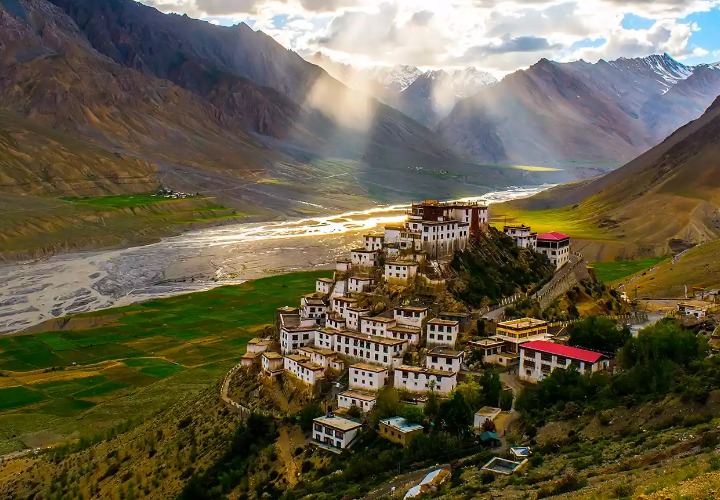The travel Guide to spiti valley everything you need to know
Nestled in the heart of the mighty Himalayas, Spiti Valley is a remote and enchanting destination that offers breathtaking landscapes, ancient monasteries, and a unique cultural experience. This travel guide will equip you with everything you need to know before embarking on your journey to this untouched paradise.
1. Best Time to Visit:
Spiti Valley is a high-altitude desert, so the ideal time to visit is during the summer months, from May to September. This period allows you to avoid heavy snowfall and road closures, ensuring a smooth and enjoyable trip.
2. How to Reach Spiti Valley:
Access to Spiti Valley can be challenging, but the journey is well worth it. The two main routes to reach Spiti are from Manali via the famous Rohtang Pass or from Shimla via the Hindustan-Tibet Road. Both routes offer stunning views, but be prepared for narrow and winding roads.
3. Permits and Documents:
Before visiting Spiti Valley, make sure you have all the necessary permits and documents. Foreign nationals require an Inner Line Permit (ILP), which can be obtained in Shimla or Reckong Peo. Indian nationals can obtain the permit in Reckong Peo or Kaza. Carry multiple copies of your identification and passport-sized photographs.
4. Places to Visit:
a. Key Monastery: One of the largest and oldest monasteries in Spiti Valley, Key Monastery is perched on top of a hill and offers panoramic views of the valley. Explore its ancient prayer halls, murals, and artifacts while experiencing the spiritual ambiance.
b. Chandratal Lake: Known as the "Moon Lake," Chandratal is a mesmerizing high-altitude lake surrounded by snow-capped mountains. Camping near the lake is a must-do experience, allowing you to witness the magical play of colors during sunrise and sunset.
c. Pin Valley National Park: Home to diverse flora and fauna, Pin Valley National Park is a haven for wildlife enthusiasts. Spot rare species like snow leopards, ibex, and Himalayan birds as you hike through its rugged terrain.
d. Dhankar Monastery: Perched dramatically on a cliff, Dhankar Monastery offers stunning panoramic views of the Spiti Valley. Explore its ancient frescoes, statues, and meditation caves while immersing yourself in the tranquility of the surroundings.
5. Trekking and Adventure Activities:
Spiti Valley offers numerous trekking opportunities for adventure enthusiasts. The famous Spiti to Parvati Valley trek, Pin Parvati Pass trek, and Hampta Pass trek are some of the popular options. Engage in rock climbing, river rafting, and mountain biking to get an adrenaline rush amidst the majestic Himalayan landscape.
6. Local Cuisine and Culture:
Indulge in the local cuisine of Spiti Valley, which includes momos, thukpa (noodle soup), and butter tea. Immerse yourself in the unique culture of the region by visiting local villages like Kibber and Langza, interacting with the warm-hearted locals, and witnessing traditional festivals and rituals.
7. Accommodation Options:
While Spiti Valley is a remote destination, there are several accommodation options available to suit different budgets and preferences. From cozy guesthouses and homestays in the local villages to comfortable hotels and resorts in towns like Kaza and Tabo, you'll find a variety of choices. Camping is also a popular option for those seeking a closer connection with nature.
8. Safety Precautions:
Given the high altitude and challenging terrain of Spiti Valley, it's important to take certain safety precautions. Acclimatize properly to avoid altitude sickness, stay hydrated, and carry necessary medications. It's advisable to have a reliable vehicle, preferably a 4x4, and drive cautiously due to the narrow and sometimes treacherous roads. It's also recommended to have a local guide or join a guided tour for a safer and more informed experience.
9. Photography Tips:
Spiti Valley offers endless opportunities for photography enthusiasts. Capture the stunning landscapes, vibrant prayer flags, and ancient monasteries in their full glory. The best time for photography is during sunrise and sunset when the light is soft and golden. Don't forget to carry extra batteries and memory cards, as electricity and internet connectivity can be limited in certain areas.
10. Responsible Travel:
Spiti Valley is a fragile ecosystem, and it's important to practice responsible travel to preserve its natural beauty and cultural heritage. Respect the local customs and traditions, seek permission before photographing people, and avoid littering. Protect the fragile environment by refraining from plucking flowers or disturbing wildlife. Opt for eco-friendly accommodations and support local businesses to contribute to the sustainability of the region.
11. Additional Tips:
- Carry sufficient cash, as ATMs may not be easily accessible in some areas.
- Dress in layers to adapt to the changing weather conditions.
- Pack essential items like sunscreen, sunglasses, a hat, and a good pair of walking shoes.
- Stay updated on road conditions and weather forecasts before embarking on your journey.
- Keep a first aid kit handy with basic medications and supplies.
Conclusion:
Spiti Valley is a destination that will captivate your senses and leave you with lasting memories. By following this comprehensive travel guide, you'll be well-prepared to explore the awe-inspiring landscapes, immerse yourself in the rich culture, and experience the adventure that awaits in this Himalayan gem. So, embark on your journey with an open heart and a spirit of exploration, and let Spiti Valley work its magic on you.

